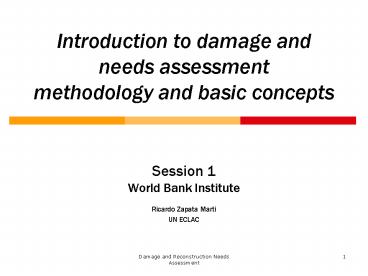Introduction to damage and needs assessment methodology and basic concepts - PowerPoint PPT Presentation
1 / 15
Title:
Introduction to damage and needs assessment methodology and basic concepts
Description:
Title: PowerPoint Presentation Author: SAWBI003 Last modified by: wb326993 Created Date: 5/24/2004 4:28:12 PM Document presentation format: On-screen Show (4:3) – PowerPoint PPT presentation
Number of Views:107
Avg rating:3.0/5.0
Title: Introduction to damage and needs assessment methodology and basic concepts
1
Introduction to damage and needs
assessmentmethodology and basic concepts
- Session 1World Bank InstituteRicardo Zapata
Marti - UN ECLAC
1
1
2
Purposes of disaster valuation
- Serve as a means to mobilize external
cooperation, assistance and loans - Become a tool in policy formulation and
post-disaster resource allocation - Become a tool in long-term risk mitigation
strategy setting - Determine needs for reconstruction and
mitigation - Create historical record
2
2
3
Information needs of disaster valuation
- Type
- Contribution of analysts in all sectors of the
economy, as well as social scientists - Geographically specific information
- Final analysis must have both disaggregated and
national accounting versions - Sources
- Ex ante data (pre-existing conditions, baselines)
- Ex-post data (on the basis of numerous sources
and estimates from the affected population to
economic, social and environmental effects. Can
be both primary and second-hand.)
3
3
4
Disasters framework for valuation
4
4
5
Vulnerability
Exposure to risks given the existing
institutional and socioeconomic situation,
manifested in
- Marginalization,
- Informal housing and economy,
- Poverty,
- Conditions in human settlements and the
situationof productive activities (primary,
industrial, tertiaryor services) their linkage
internally and with the environment.
5
5
6
Phases in a disaster
The disaster cycle
- Emergency
- Rehabilitation
- Reconstruction
- Prevention and Mitigation
- Alert and Preparation
6
6
7
The disaster cycle and needs assessment
- Emergency
- In the immediate aftermath,
priority is to save lives - Assessment efforts can begin affected
population, deaths, wounded,
missing, direct damages to property and
infrastructure, both public and
private.
- Rehabilitation
- Priority is to return activities in
the affected area to normal. - Assessment of direct and indirect
damages can begin, and an appraisal
should be initiated of secondary
effects.
- Reconstruction
- Priority is to implement mitigation
so that pre-disaster vulnerability is
not rebuilt. - Ex construction projects modify
pre-existing infrastructure and
environmental conditions that led to
damage by the disaster.
7
8
Connecting the cycle link between needs
assessment and mitigation
- Mitigation measures rely on specific information
provided by the needs assessment - Mitigation includes
- Allocating resources toward institutional,
organizationaland structural measures - Training and organization, including at the
community level - Devising early warning systems
- Ownership of actions is fundamental to build
trust
8
8
9
Timeliness and accuracy of valuation
- Window of need Window of opportunity
- Timely response to needs
- Valuation must aim to reduce disaster impact and
avoid reconstruction of preexisting vulnerability - Assessment must be done in time to mobilize
necessary internal and / or external resources to
help - Accuracy
- Valuation must aim to ensure comparability and
methodological consistency, and - To be acceptable by technical standards
- Judgment calls, assumptions and indirect
calculations are necessary - The acceptable margin of error is 10-12
- Valuation must nonetheless be accurate enough to
attract investment and projects
9
9
10
Disaster valuation concepts
- Direct damages
- Impact on assets
- Infrastructure
- Capital
- Stocks
- Occur immediately during or after the phenomenon
that caused the disaster
- Indirect damages
- Effects on flows
- Production
- Reduced income and increased expenses
- Are perceived after the phenomenon, for a
time-period that can last from weeks to months,
till recuperation occurs
10
10
11
Sector by sector valuation methodology
- Social Sectors
- Housing
- Health
- Education, culture, sports
- Infrastructure
- Transport and communications
- Energy
- Water and sewerage
- Productive sectors
- Goods agriculture, industry
- Services commerce, tourism, etc.
- Global impact
- On the environment
- Gender perspective
- Employment and social conditions
- Macroeconomic assessment
11
11
12
Social sector
- Each social groups degree of vulnerability to a
natural disaster is different, and the severity
of negative impact of natural disasters is as
directly related to social inequalities and
deprivations as to the natural hazard itself. - A Social Impact Assessment (SIA) can be crucial
in determining - What mitigation is necessary
- What mitigation alternatives exist
- Which mitigation strategies are most likely to
work - Accurate assessments of impacts should pay
attention to gendered differentials and must be
based on sound pre-existing socio-demographic
data
13
Dynamic global effects
- Macroeconomic effects
- Repercussions on the national or regional economy
after disaster - The duration of repercussions depending on the
characteristics and magnitude of disaster - The effects are reflected by
- Gross Domestic Product growth
- Performance of the external sector
- Evolution of public finance
- Increases of prices and inflation
14
Disaster risk reduction
- Internal policies
- Include vulnerability reduction as an objective
of development plans alongside goals of - Competitive growth
- Equitable development
- Sustainable and sustained development
- Social participation
- External policies
- Introduce risk management as part of the
regional/international agenda, alongside - External competitive insertion
- Benefiting from the globalization process
- Inclusive regional insertion
15
Disaster risk reduction
- Sectoral components
- Monitoring, analysis and climate forecasting,
including at the local level - Contingency plans in key sectors, for example
- Agriculture, cattle raising,
- Rural poverty,
- Energy and baselines
- Water and health
- Interconnected systems
- Regulation of basic services with sponsorship of
private enterprise - Focused plans for vulnerable groups, including
for employment, food availability and nutrition - Education to reduce vulnerability































